
Lychee: The Exotic Vietnamese Fruit That’s Bursting with Flavor
Lychee may look a little strange at first—with its rough red skin—but inside is a juicy, fragrant fruit that’s sweet, refreshing. In this article, we’ll cover what lychee looks and tastes like, how it’s grown and harvested in Vietnam, when it’s in season, and how to peel and enjoy it. You’ll also learn about its nutritional value, traditional uses, and how it’s featured in Vietnamese drinks and desserts.
What is lychee
Taste & flavor
Lychee season
Growing & harvesting
Nutrition facts
How to eat
Lychee in Vietnamese life
FAQs
What is the fruit lychee?
Overview
 Vietnamese name: vai, vai thieu
Vietnamese name: vai, vai thieu Shape and appearance: small, round to slightly oval, with rough red to pink skin; inside is translucent white flesh that surrounds a single dark seed.
Shape and appearance: small, round to slightly oval, with rough red to pink skin; inside is translucent white flesh that surrounds a single dark seed. Flavor profile: juicy and sweet, with a light floral aroma and a gentle tang.
Flavor profile: juicy and sweet, with a light floral aroma and a gentle tang. How to enjoy it: Enjoy lychees fresh, in tea, sweet soups, or tropical desserts—or try them dried, in smoothies, or even stir-fried with rice for a creative twist.
How to enjoy it: Enjoy lychees fresh, in tea, sweet soups, or tropical desserts—or try them dried, in smoothies, or even stir-fried with rice for a creative twist. Harvest season: lychee is harvested from May to July in Vietnam.
Harvest season: lychee is harvested from May to July in Vietnam.Shape and color of lychee
Lychee is a round or slightly oval fruit, usually about 3 to 5 centimeters long and around 3 centimeters in diameter. Its outer skin is rough and bumpy, covered in small, raised nodules. When ripe, the skin turns pink to red, with a textured surface that feels slightly dry to the touch. This appearance is typical of fresh Vietnamese lychees at peak ripeness.
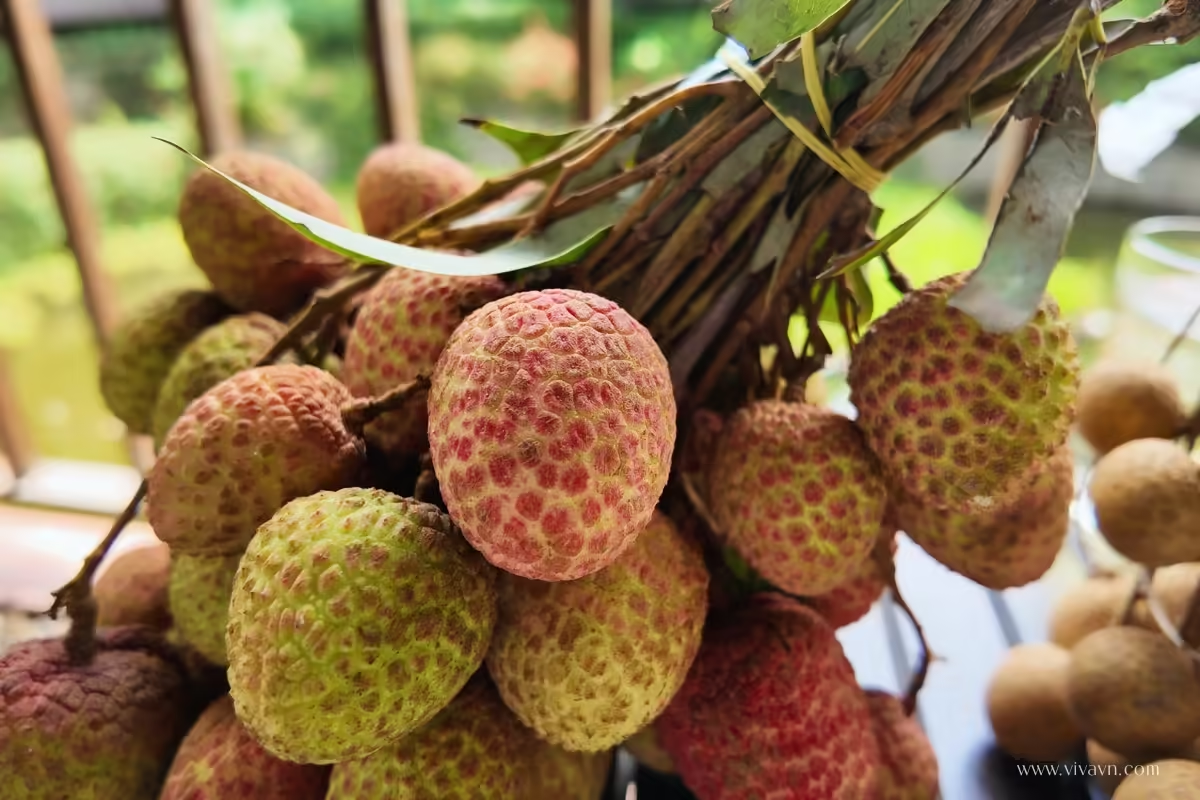
This image shows ripe Vietnamese lychees with their pink-red skin and bumpy texture, indicating they’re ready to eat.
Earlier in the growing season, lychees are still green and firm. As they ripen on the tree, the skin gradually changes color, and the fruit inside becomes juicy, sweet, and aromatic. Being able to spot this change is helpful whether you’re harvesting them fresh or shopping at a local market.
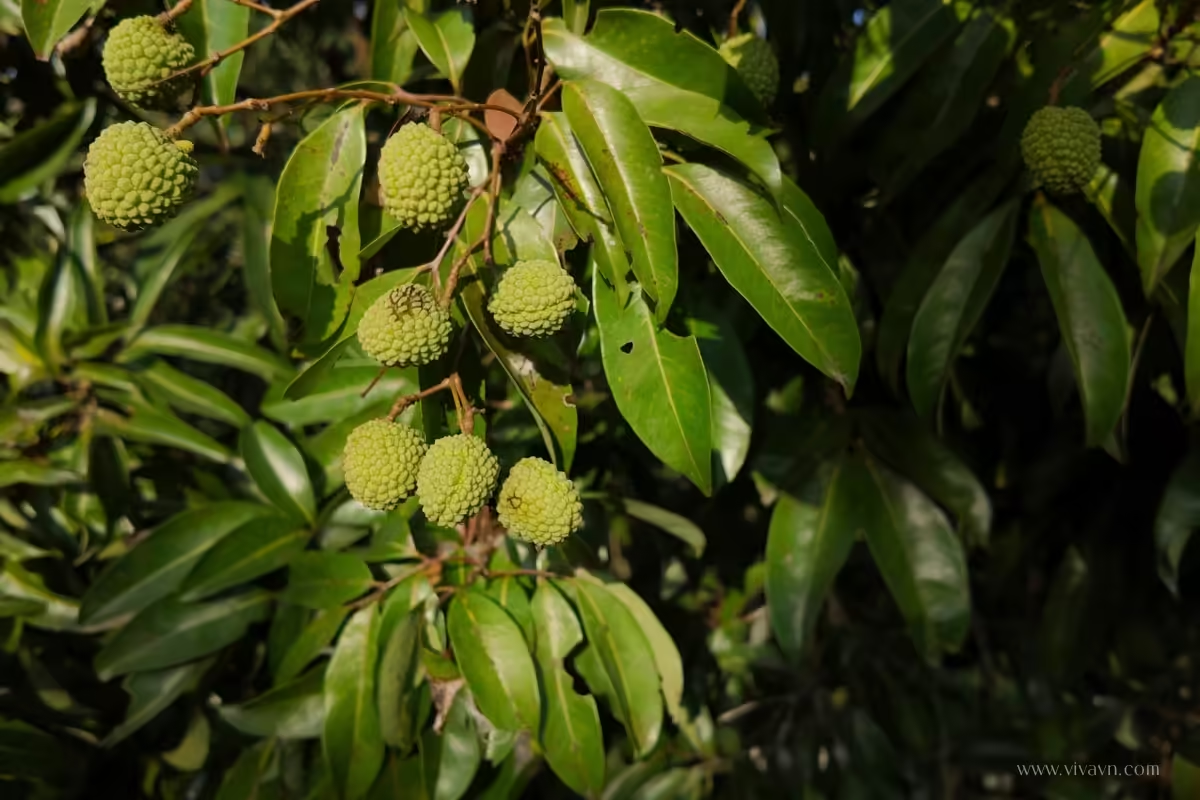
This image shows unripe lychee fruits still hanging on the tree, with firm green skin and a bumpy texture.
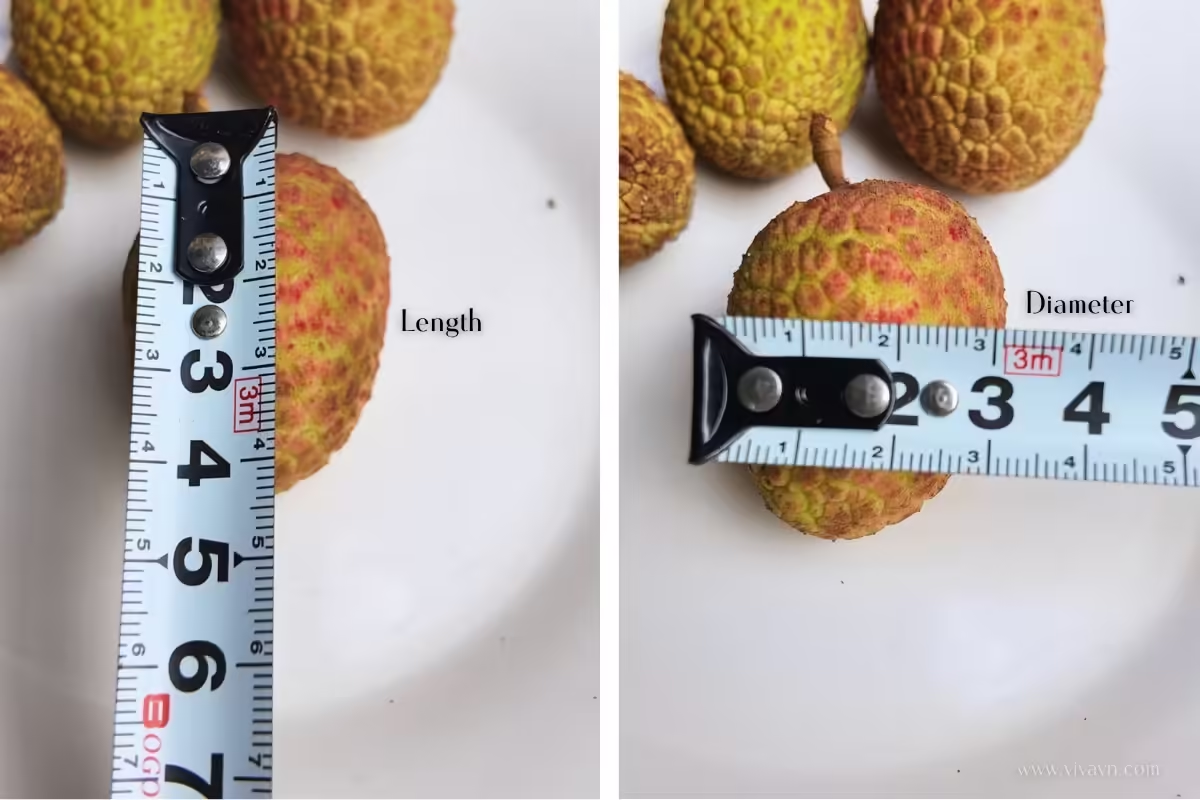
This image shows the actual size of a typical lychee, with a ruler used to measure both its length and diameter.
What’s inside a lychee
Inside a lychee, you’ll find thick, soft, and translucent flesh. At the center is a single smooth, brown seed, which isn’t edible. It’s the refreshing white flesh that people love—perfect for snacking, desserts, or tropical drinks.
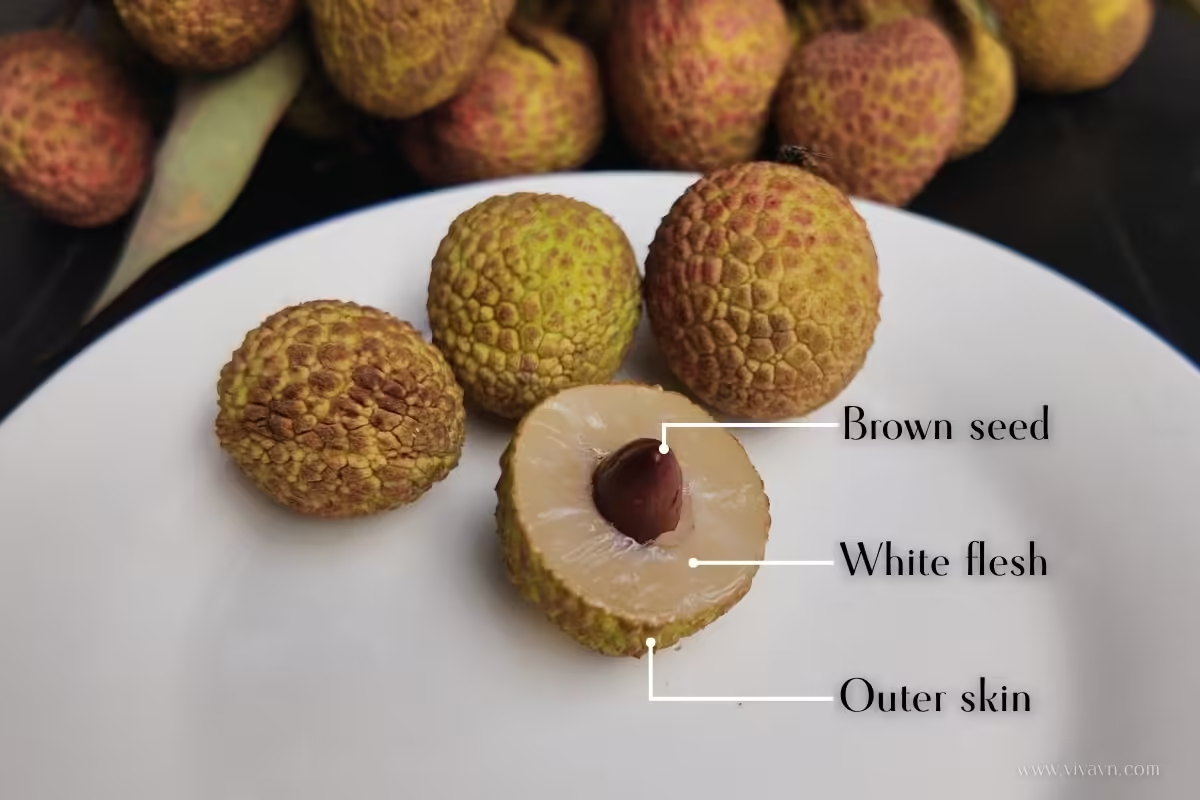
A close-up shot of a ripe lychee, sliced open to show its juicy flesh and seed.
Taste and flavor of lychee
Sweetness and aroma
Ripe lychees have a naturally rich sweetness with a hint of tartness. The flesh is soft, juicy, and refreshing. In Vietnam, lychees from Luc Ngan, Bac Giang – one of the country’s most renowned lychee-growing regions – are prized for their floral aroma, tender texture, and deep sweetness, with a natural sugar content (Brix level) ranging from 18% to 21% source (Vietnamese).
Brix Level (°Bx) measures the sugar content in a liquid as a percentage. One degree Brix equals 1 gram of sugar (specifically sucrose) in 100 grams of liquid. It’s a common way to gauge how sweet things like fruit, juice, wine, and honey are. The higher the Brix level, the sweeter the product.

A peeled lychee reveals its juicy, translucent flesh—sweet, fragrant, and ready to enjoy.
Comparison to other fruits
Lychee is often compared to grapes because of its juicy texture and sweetness. But it has a floral aroma that sets it apart. Some say it tastes like a mix between a grape and a rose petal, with a subtle tang that’s somewhat similar to strawberry. Compared to longan, lychee is juicier and has a lighter, more refreshing scent, without the musky smell that longan naturally has. If you like fruits such as pears, grapes, strawberries, or rambutan, lychee is likely to be a refreshing favorite.
Our detailed article: Lychee vs Longan: What’s the Difference?
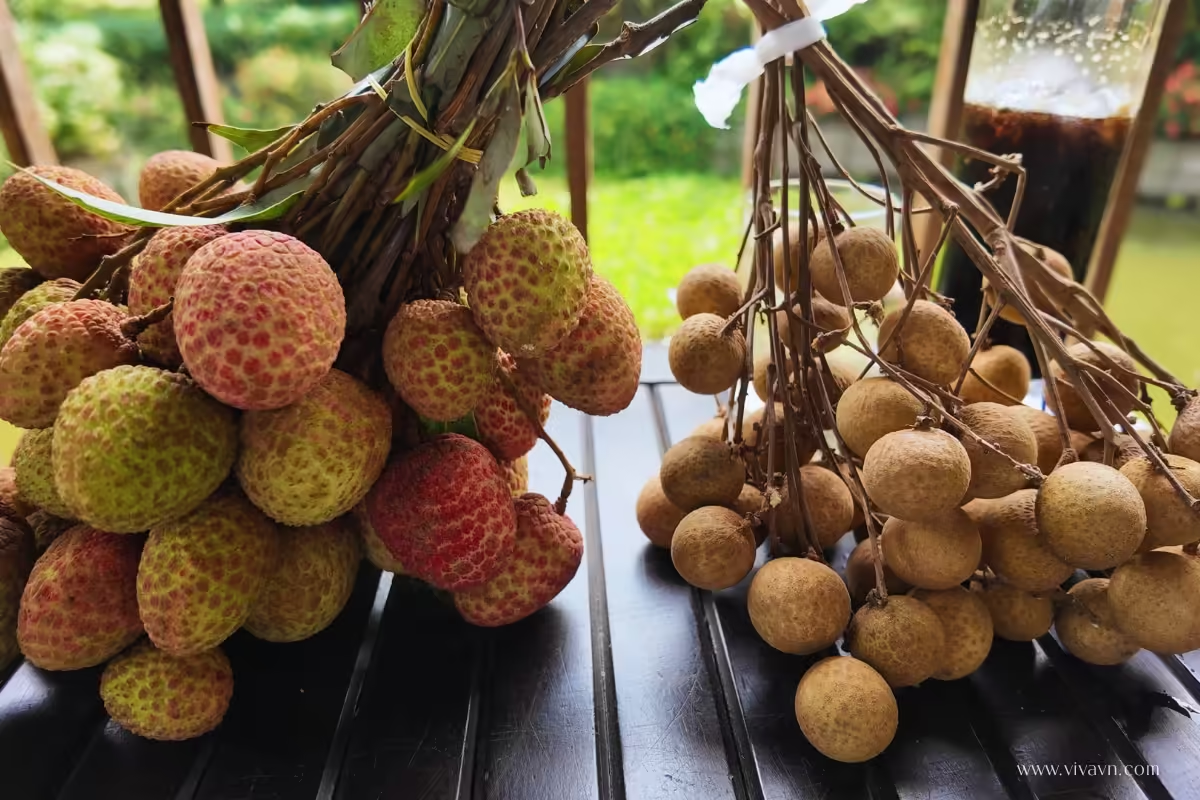
Side by side: A bunch of lychees and longans showing their clear differences in size, skin texture, and color.
When is lychee in season?
In Vietnam, lychee season runs from May to July, which is early summer to mid-summer. This is when the fruit is at its best—juicy, fragrant, and full of flavor.
The harvest is concentrated in northern provinces, especially Bac Giang and Hai Duong, where the climate and soil are ideal for growing lychee. In these regions, the season usually begins in early to mid-May, peaks in June, and wraps up by early July.
If you want to enjoy Vietnamese lychees at their freshest, the best time is from late May to mid-June, when they are widely available in markets and at their peak sweetness.
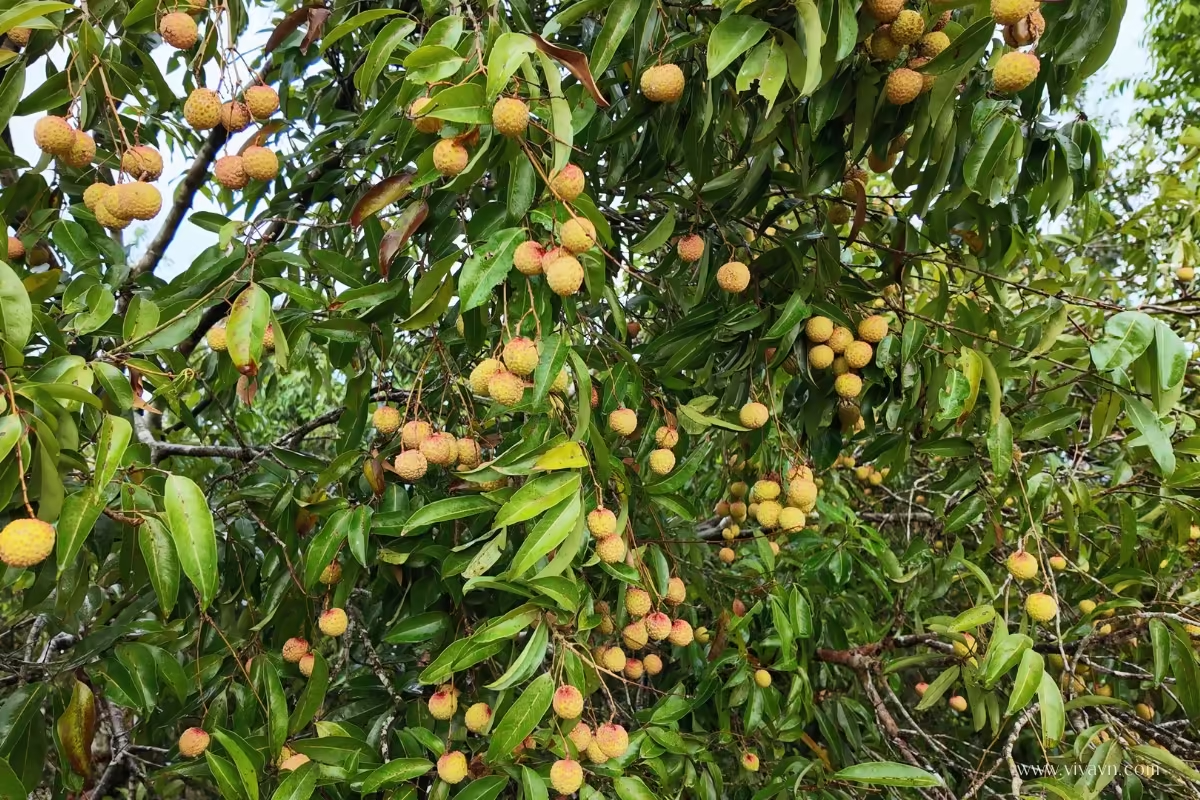
This image shows lychee fruits on the tree in Vietnam as they begin to ripen.
How lychee is grown and harvested in Vietnam
Growing conditions for lychee in Vietnam
Lychee trees thrive in tropical and subtropical climates without frost. While they need warm, humid conditions to grow, they also require a short period of cooler weather to start flowering. In Vietnam, temperatures between 11°C and 14°C for several days during winter help trigger the flowering stage. This natural chill is essential for proper bud development and ensures better fruit production in the following season.
Because of this climate requirement, lychee is only grown commercially in northern Vietnam, where the winter temperatures are suitable for flower initiation. The two main provinces known for lychee production are Bac Giang and Hai Duong, which are famous for both the quality and quantity of their lychees.
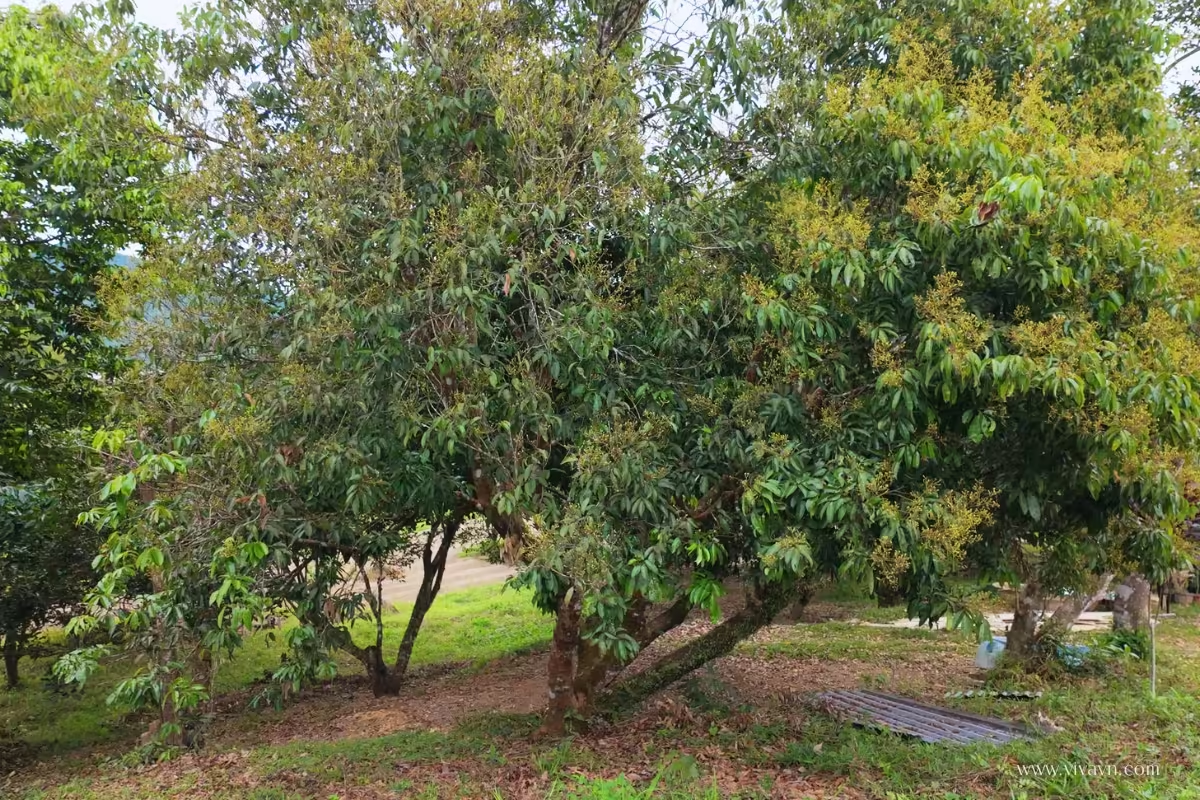
This lychee tree is entering its flowering and early fruiting stage, under ideal temperature conditions in Vietnam

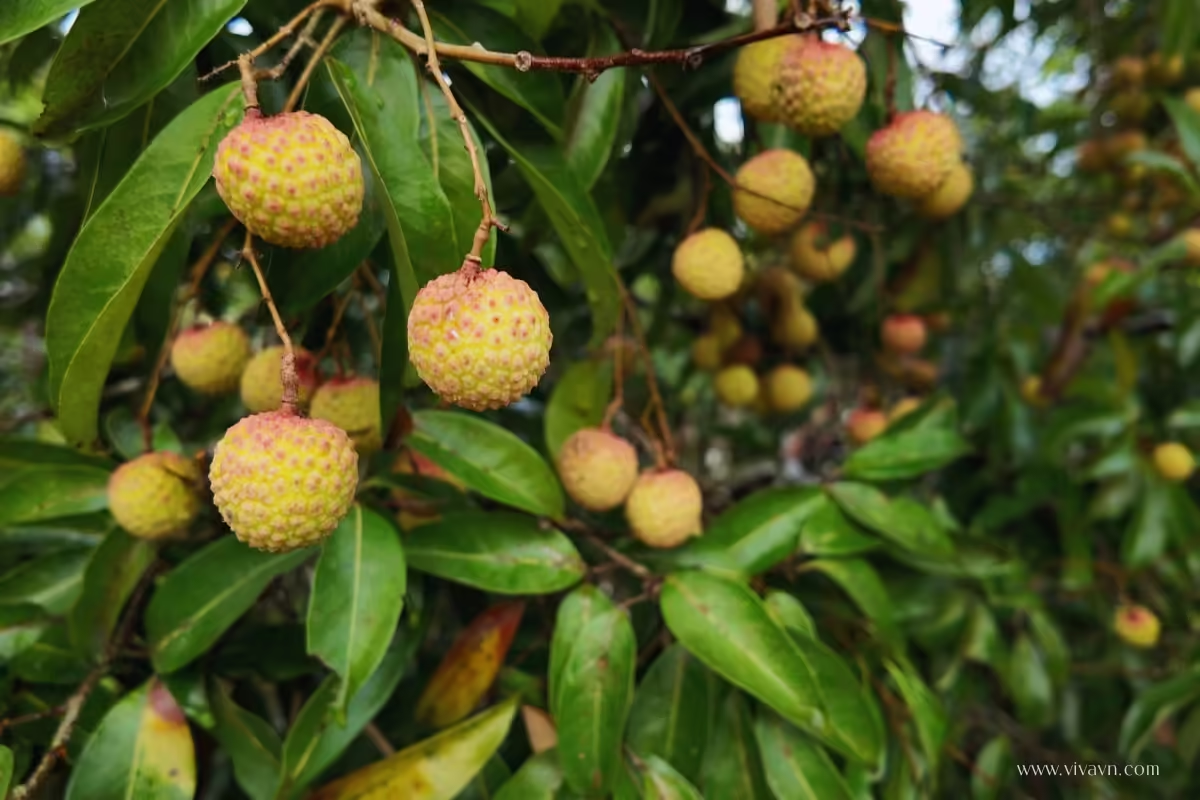
Nearly two months after flowering, this lychee tree in Vietnam now bears ripe, ready-to-harvest fruit.
Harvesting lychee in Vietnam
Farmers care for the trees year-round, from pruning branches to monitoring for pests. No large machinery is used—almost everything is done by hand. When lychees start to ripen between May and July, they’re carefully picked by hand to avoid damaging the thin skin. This hands-on approach helps keep the fruit fresh and in good condition for the market.
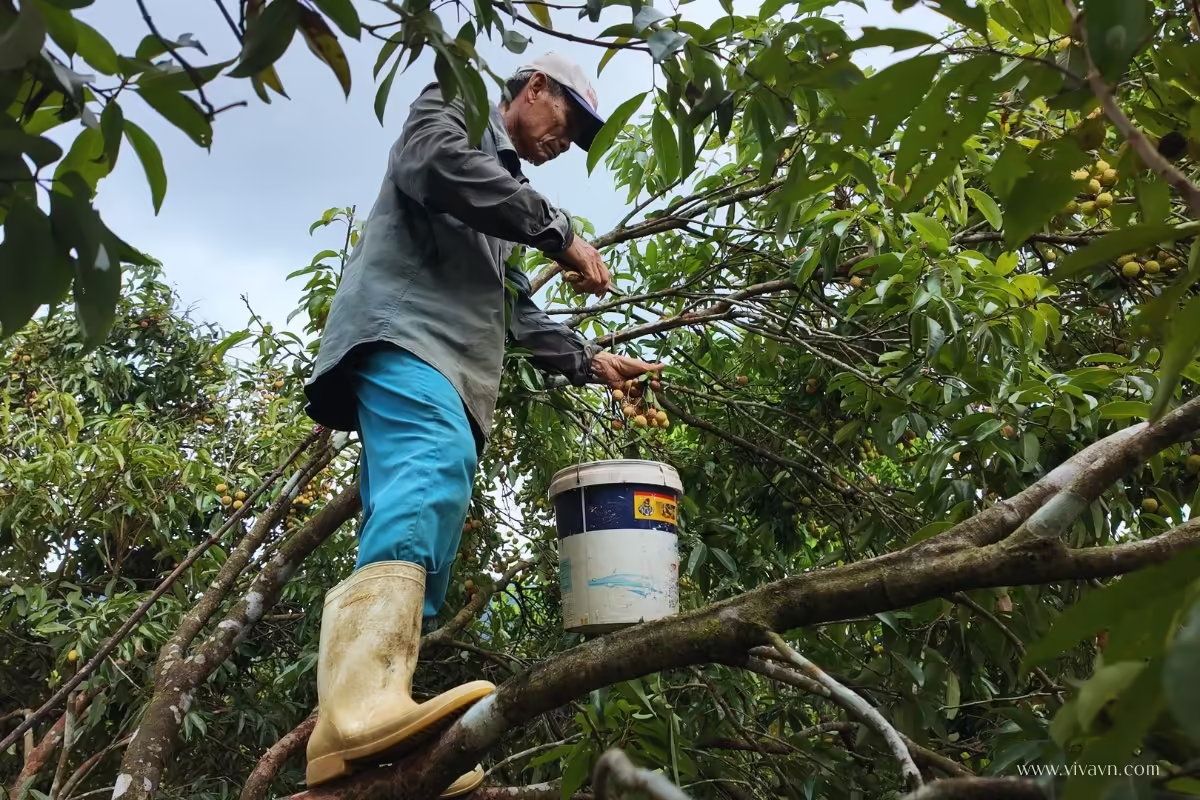
A farmer in Vietnam carefully harvesting lychees by hand during the early summer season.
Nutritional benefits of lychee
Here’s the nutritional breakdown for a 3.5-ounce (100-gram) serving of lychee, based on USDA data:
| Nutrient | Amount | Notes |
|---|---|---|
| Vitamin C | 71.5 mg | Boosts immune health and acts as a powerful antioxidant. |
| Energy | 66 kcal | Low-calorie, naturally sweet fruit—great for light snacking. |
| Total Sugars | 15.2 g | Naturally occurring sugars for quick energy. |
| Carbohydrates | 16.5 g | The main source of calories, mostly from natural sugars. |
| Water | 81.8 g | Helps keep you hydrated. |
| Fat | 0.44 g | Very low in fat |
| Potassium | 171 mg | Helps maintain blood pressure and fluid balance. |
| Fiber | 1.3 g | Aids digestion and promotes gut health. |
| Iron | 0.31 mg | Important for red blood cell function. |
| Protein | 0.83 g | Contributes a small amount to daily protein intake. |
How to eat a lychee
So you’ve got a handful of fresh lychees—now what? Here’s exactly how to eat one without making a mess:
 Step 1: Pick fruits that have bright red or pinkish skin and feel slightly soft to the touch.
Step 1: Pick fruits that have bright red or pinkish skin and feel slightly soft to the touch. Step 2: Use your fingers to peel off the thin, bumpy shell.
Step 2: Use your fingers to peel off the thin, bumpy shell. Step 3: Carefully bite or split the fruit and take out the shiny brown seed inside.
Step 3: Carefully bite or split the fruit and take out the shiny brown seed inside. Step 4: Pop the translucent flesh into your mouth and enjoy its sweet, floral flavor!
Step 4: Pop the translucent flesh into your mouth and enjoy its sweet, floral flavor!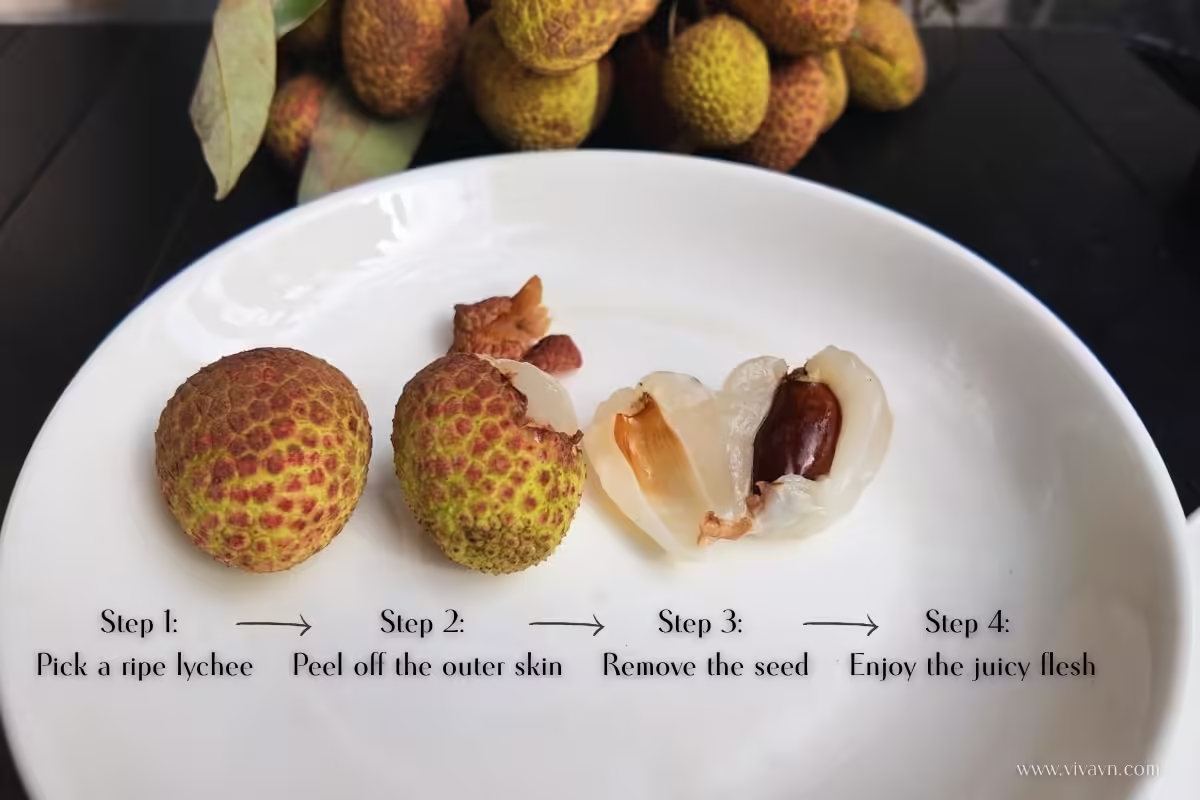
A 4-step photo guide showing how to eat a lychee
How lychee is used in Vietnamese culture, medicine, and cuisine
The cultural significance of lychee in Vietnam
In Vietnam, lychee isn’t just a summer fruit—it’s a symbol of prosperity, health, and good fortune. The fruit’s red skin is especially meaningful in Vietnamese culture, where the color red represents luck and happiness.
During Tet Doan Ngo, celebrated on the 5th day of the 5th lunar month, lychee is commonly placed on the family altar along with other traditional Vietnamese fruits. Offering a bunch of fresh lychees is a way to honor loved ones who have passed and to pray for health and blessings in the months ahead.
Beyond its role in tradition, lychee is a source of national pride. Its striking appearance, floral aroma, and sweet, juicy taste are unlike any other fruit, and many Vietnamese believe that nowhere in the world produces lychees quite like Vietnam
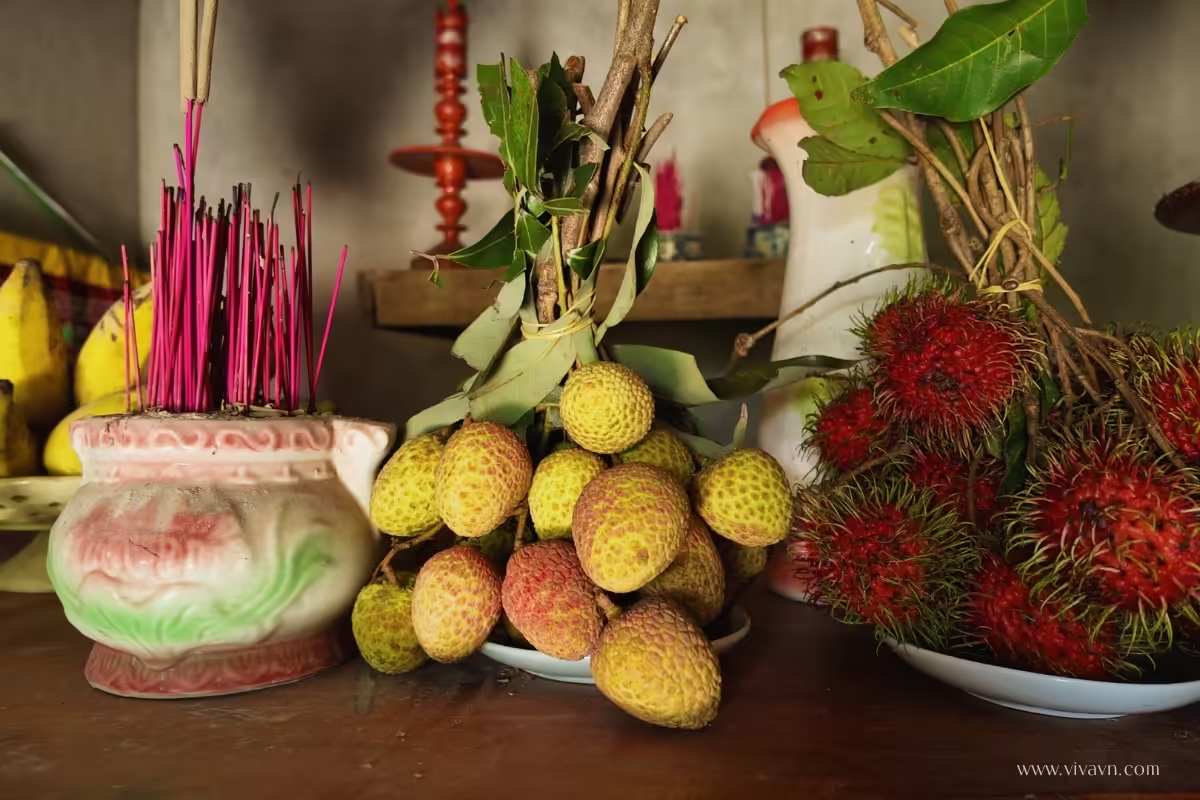
A bunch of lychees, displayed alongside other traditional fruits on a Vietnamese ancestral altar during Tet Doan Ngo
Traditional medicinal uses of lychee
Note before we begin:
These uses of lychee come from traditional Vietnamese folk remedies passed down through generations. While people still enjoy them today, they’re not backed by modern medical research, so think of them as cultural insights rather than medical advice.
In Vietnamese folk remedies, nearly every part of the lychee fruit has its own traditional use:
 Lychee peel is often dried and boiled into a tea believed to help cool the body and support detoxification.
Lychee peel is often dried and boiled into a tea believed to help cool the body and support detoxification. Fresh or dried lychee flesh is traditionally used to ease fatigue—both mental and physical—and is thought to help with muscle soreness, especially in the shoulders and lower back.
Fresh or dried lychee flesh is traditionally used to ease fatigue—both mental and physical—and is thought to help with muscle soreness, especially in the shoulders and lower back. Lychee seeds, when dried, crushed, or boiled, have been used to relieve stomach discomfort, soothe toothaches, and support blood sugar balance.
Lychee seeds, when dried, crushed, or boiled, have been used to relieve stomach discomfort, soothe toothaches, and support blood sugar balance.Lychee in traditional Vietnamese cuisine
Dried lychees: Sweet, chewy, and long-lasting
While fresh lychees are perfect for snacking and summer drinks, drying them is a great way to preserve their unique flavor. In Vietnam, the fruits are often dried with the skin still on. During the process, the flesh gradually darkens and develops a chewy texture with rich, caramel-like sweetness. It’s a traditional method, especially popular during lychee season, and it makes for a delicious treat that lasts well beyond summer
Lychee tea
Lychee tea is a refreshing summer drink that blends the floral sweetness of lychee with the slight bitterness of brewed tea. Typically made with fresh lychees, oolong tea, and rock sugar, it’s chilled and served over ice—perfect for beating the tropical heat. Popular during lychee season, this drink is both flavorful and easy to make at home.
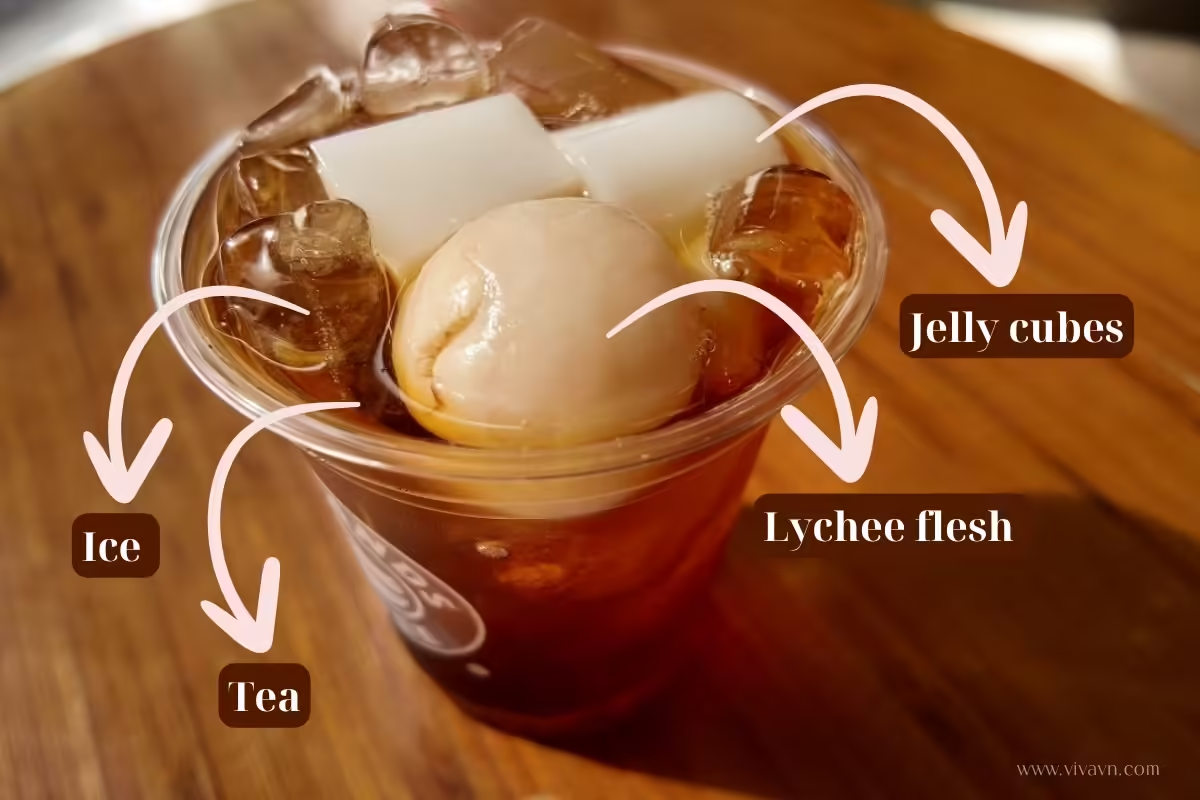
A chilled glass of Vietnamese lychee tea, made with fresh lychee fruit, jelly, ice, and oolong tea
Lychee and lotus seed sweet soup
This light and soothing dessert combines tender lotus seeds with juicy lychee for a naturally sweet treat. The lotus seeds are gently simmered until soft, then tucked into peeled lychees before being briefly cooked in a fragrant syrup. It’s a popular summertime dish in Vietnam—cool, refreshing, and simple to make at home.
Lychee fried rice
This creative Vietnamese dish brings a tropical twist to classic fried rice. Originating from the Mekong Delta, it’s made by stir-frying steamed rice with juicy lychee, eggs, and savory ingredients like sausage or char siu. As everything sizzles together in the pan, the lychee softens and releases a gentle sweetness that blends beautifully with the richness of the rice and proteins
Frequently asked questions about lychee
What is lychee and what does it taste like?
Lychee is a small tropical fruit with a rough red skin and juicy, translucent white flesh inside. It has a sweet, refreshing taste with a light floral aroma and a subtle tanginess.
When is lychee season in Vietnam?
In Vietnam, lychee season runs from May to July, with peak ripeness typically between late May and mid-June. This is when the fruit is at its juiciest, most fragrant, and full of flavor.
How do you eat a lychee properly?
To eat a lychee, choose one with red or pink skin that feels slightly soft. Peel off the thin, bumpy shell with your fingers, remove the shiny brown seed, and enjoy the juicy flesh. It’s best eaten fresh, but also works well in drinks and desserts.
Are lychee seeds edible?
No, lychee seeds are not edible. They are smooth and brown and should be removed before eating the flesh. In folk medicine, however, dried lychee seeds have been used to support digestion and relieve certain discomforts.
How is lychee used in Vietnamese cuisine?
Lychee is used in a variety of Vietnamese dishes and drinks. Fresh lychees are enjoyed as snacks or in smoothies. They’re also featured in lychee tea, sweet soups with lotus seeds, and even stir-fried rice dishes for a tropical twist.
Is dried lychee common in Vietnam?
Yes, especially during lychee season. In Vietnam, lychees are often dried with their skin still on, which helps concentrate their sweetness and develop a chewy, caramel-like texture. It’s a traditional method of preservation.
What is the cultural significance of lychee in Vietnam?
Lychee symbolizes prosperity, health, and luck in Vietnam. During Tet Doan Ngo, it’s commonly placed on family altars as an offering to ancestors. The fruit’s red skin represents good fortune and happiness in Vietnamese tradition.
Share on FacebookShare on X (Twitter)Share on PinterestShare on WhatsappShare on LinkedinShare on TelegramShare on Email
- https://www.youtube.com/@VivaVNOfficial
- https://www.facebook.com/vivavnofficial2024
- https://www.pinterest.com/vivavnofficial/
© 2025 VivaVN. All rights reserved.


Leave a Reply